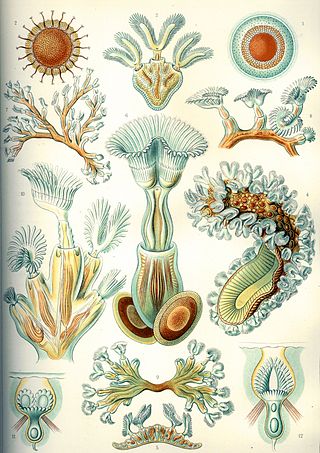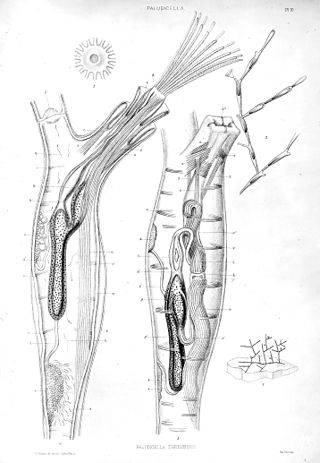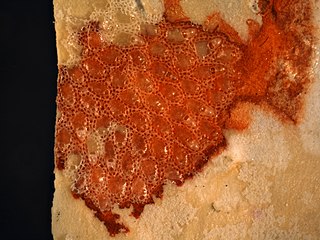
Bryozoa are a phylum of simple, aquatic invertebrate animals, nearly all living in sedentary colonies. Typically about 0.5 millimetres long, they have a special feeding structure called a lophophore, a "crown" of tentacles used for filter feeding. Most marine bryozoans live in tropical waters, but a few are found in oceanic trenches and polar waters. The bryozoans are classified as the marine bryozoans (Stenolaemata), freshwater bryozoans (Phylactolaemata), and mostly-marine bryozoans (Gymnolaemata), a few members of which prefer brackish water. 5,869 living species are known. At least two genera are solitary ; the rest are colonial.
Stenolaemata are a class of exclusively marine bryozoans. Stenolaemates originated and diversified in the Ordovician, and more than 600 species are still alive today. All extant (living) species are in the order Cyclostomatida, the third-largest order of living bryozoans.

The Catenicellidae are a family of bryozoans in the suborder Flustrina.
The Adeonellidae is a family within the bryozoan order Cheilostomatida. Colonies are often upright bilaminar branches or sheets. The zooids generally have one or more adventitious avicularia on their frontal wall. Instead of ovicells the adeonids often possess enlarged polymorphs which brood the larvae internally.

Cristatella mucedo is a bryozoan in the family Cristatellidae, and the only species of the genus Cristatella. They are noted for their elongated shape and colorless, transparent bodies.

Paludicella is a genus of freshwater bryozoans in the family Paludicellidae.

Schizoporella unicornis is a species of bryozoans in the family Schizoporellidae. Species have been found intertidally around oyster beds in Georgia. However, the origins of this species are likely from British Columbia.
Articulina is an extant suborder of bryozoans in the order Cyclostomatida.
Stomatoporina is a genus of stenolaematan bryozoans. The type species is Stomatoporina incurvata. Like almost all bryozoans, it is colonial.

Conopeum seurati is a species of colonial bryozoan in the order Cheilostomatida. It is native to the northeastern Atlantic Ocean, the North Sea and the Mediterranean Sea. This species has been introduced to New Zealand and Florida.
Fenestrulina rugula is a bryozoan species from the genus Fenestrulina. The scientific name of the species was first published in 1990 by Hayward & Ryland.

Bugula neritina is a cryptic species complex of sessile marine animal in the genus Bugula. It has a practically cosmopolitan distribution, being found in temperate and tropical waters around the world, and it has become an invasive species in numerous locations. It is often found in hard substrates, such as rocks, shells, pillars and ship hulls, where it can form dense mats, contributing to biofouling. B. neritina is of biomedical interest because it harbors a bacterial symbiont that produces a group of bioactive compounds with potential applications in the treatment of numerous diseases.
Callopora lineata is a species of colonial bryozoan in the family Calloporidae. It is found on rocky shores in the Atlantic Ocean and the Mediterranean Sea.

Chorizopora brongniartii is a species of bryozoan in the family Chorizoporidae. It is an encrusting bryozoan, the colonies forming spreading patches. It has a widespread distribution in tropical and temperate seas.
Columnella is a genus of bryozoans belonging to the family Farciminariidae.
Bugulina is a genus of bryozoans in the family Bugulidae.
Acanthoceramoporella is an extinct genus of cystoporate bryozoans from the Ordovician period.
Quadrisemicoscinium is an extinct genus of fenestrate bryozoan, known from the Early Devonian period, of the family Semicosciniidae. It formed net-like colonies of relatively thick branches with two rows of autozooids per branch, supported by a vesicular skeleton.
Paralicornia sinuosa is a species of colonial bryozoan in the Paralicornia genus, found in the Indo-Pacific region. It was originally classified as a member of the Scrupocellaria genus.
Spiritopora is a genus of marine invertebrate. The only known species is Spiritopora perplexa which is endemic to New Zealand. It is a cyclostome bryozoan, in the family Diaperoeciidae and order Cyclostomatida, described by Taylor and Gordon in 2003.







